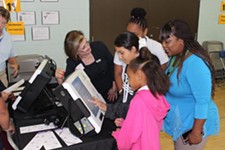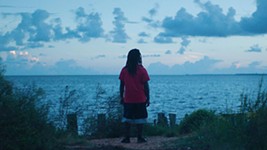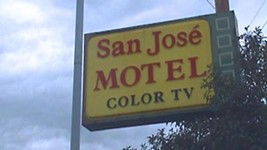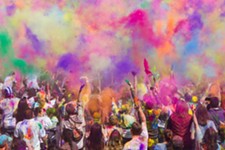A Funny Thing Happened on the Way to the Voting Booth
AFS Documentary Tour presents 'Election Day'
By Anne S. Lewis, Fri., Nov. 7, 2008
By the time you read this, you will most likely have experienced the 2008 version of the subject of Katy Chevigny's film, Election Day, which is – wait for it – Election Day '04. Which means you'll be able to compare your experience earlier this week with those that Chevigny collected when she deployed 14 fly-on-the-wall camera crews to the same number of precincts around the country in search of revelatory polling-place moments and stories. If that sounds oxymoronic, let me assure you: It's not. Even without 2000's hanging chads, there was plenty of human drama to go around – both in front of and behind the long tables with the voter registration printouts. Beyond the amazing sight of all those fellow Americans – from the country's metropolises to its American Indian reservations – busied on the same day with the same task, one can't help but be struck by the extraordinary "low-techness" of it all. In high tech, high-stakes times like these, it's fairly astounding to realize that the possibility of human error (nefarious, negligent, or innocent) looms at every juncture, threatening to subvert one leg or another of a very earnest civic process. But, of course, it's that earnestness – on the faces of those standing in line for hours in the cold and rain to exercise their franchise on issues local and national – that makes you realize what a great country this is.
Making it into Chevigny's panoramic day-in-the-life snapshot of the American electorate were stories from 11 of the 14 locations she sent crews to. We watch a 50-year-old ex-felon in New York, who, newly eligible to vote since completing his parole, excitedly presents himself at the poll only to be told that his name was not on the list of registered voters. On the other side of an annoying hurdle of red tape, he's finally allowed to vote on a provisional ballot. (Weeks after the election, he will learn that due to a registration snafu, his vote was not counted.) Meanwhile, a dishwasher at a restaurant in Orlando, Fla., also an ex-felon but, under that state's laws, nonetheless still ineligible to vote, talks about how difficult Florida makes it for ex-felons to ever vote again. (Nationwide, under varying state laws, close to 2 million ex-felons are ineligible to vote.)
Other scenes take us to polls in Cincinnati, where the brother of a write-in candidate for county prosecutor hustles to pass out pencils to prospective voters. And then at the Pine Ridge Reservation in Pine Ridge, S.D., we see volunteers working hard to get thousands of American Indians to the polls to vote in the tribal and U.S. federal elections held on the same day. On a reservation that extends hundreds of miles, driving voters to the polls and bringing food to the poll workers is a huge task.
Austin Chronicle: Can you describe, from your filmmaker's perspective, the anxiety of having a one-day, make-or-break shoot where you had no idea what you were going to get from the cinematographers you'd sent out in the field.
Katy Chevigny: Whenever you're making a documentary in the cinema verité style – or observational style as some call it – there is a lot of anxiety about whether or not anything of interest will transpire in front of your camera lens. And since I had already committed to the concept of making a film that would be shot on one day – that is, Election Day – I was invested in trying to increase the chances that we would in fact have a movie after we completed shooting on November 2, 2004. For these reasons, we shot in multiple locations. We spent eight weeks prior to the election doing research on interesting issues, locations, and stories that we might consider following in the film. I wanted to make sure we had a range of American lives and types of voting experience, and I wanted to focus our attention away from the campaign fight between the presidential candidates. We chose a range of stories, essentially "casting" several documentary characters who we conducted preinterviews with by phone. We intentionally chose stories with some overlaps in themes so that if a location or two didn't work out, we'd still have other locations that would cover some of the important themes. I was guessing that perhaps half the locations would not generate footage that would warrant inclusion in the film, but in fact, most of the locations were interesting.
It was an incredible experience from a production standpoint because in the days following the election, we received FedEx packages from each of our crews around the country and went from having zero hours of footage to having 105 hours – within a 24-hour shooting period!
AC: How were you able to control the shoot?
KC: One of the big challenges in making the film was communicating with the field producers and camera people about how to approach their subject matter so that there was a consistent look of the footage throughout all the locations. I had a fear that without proper preparation, the final film would end up looking like some pastiche of 14 different movies. I wanted it to look like it was all shot for the same movie. In order to do this, I wrote a document that I sent to each of the crews and followed up with an hourlong conference call in which we discussed not just camera settings, which were consistent across crews, but also the attitude of a cinema verité crew versus the style of a TV news crew. I actually felt pleased to discover how consistent most of the footage was – and was reminded of how important and specific a skill it is to be a verité shooter.
AC: Was it difficult to gain admittance to the polling places?
KC: One of the other great challenges was getting permission to shoot in polling places around the country. We spent weeks of production attempting and often failing to get permission to film within polling places. I instructed the crews to do everything in their power to get into polling places and film. I told them to respect the individual voter's privacy but to feel entitled to enter the polling place to film the general action inside, that it is our First Amendment right to document this important public process. In most cases, crews were able to get into polls to film. In Florida, they have a statewide rule banning cameras in polling places, so we were unable to get footage there.
AC: What surprised you about the snapshot of the country on Election Day '04?
KC: I had not expected to make a film that so clearly showed the tenacity of racial division, even de facto segregation, in America. But the footage we watched in the edit room so vividly showed disparities in access due to race and, in effect, class, that we had to show that reality in the final film, as well. I was also surprised to hear that there were Americans who consider voting to be a "privilege" rather than a right. We heard more than one person say this, in different states, and I said: "Hmm, this must really be a belief of a segment of the population. We should include this in the film." ... I do hope that many viewers walk away with a deeper insight into the shortcomings of our current election system. In my view, we have a ways to go before we can really say with confidence that we have guaranteed the full and fair enfranchisement of our electorate. And I think we should feel dissatisfied with the system we have and fight for a better one.
The AFS Documentary Tour presents Election Day on Wednesday, Nov. 12, 7pm, at the Alamo Drafthouse at the Ritz. Producer Maggie Bowman and editor Penelope Falk will be in attendance for a post-screening Q&A. Tickets are $4 for AFS members and $6 for the general public. For more information, visit www.austinfilm.org.











